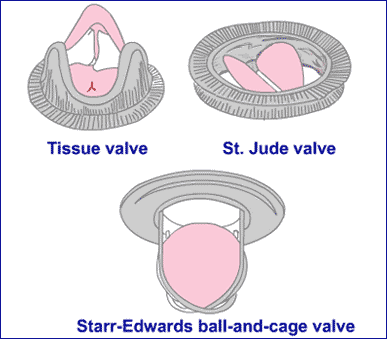Mitral Valve Replacement
Mitral Valve replacement like valve repair is an open-heart procedure where the patient’s diseased mitral valve is removed and replaced by an artificial or prosthetic valve.
There are two main types of prosthetic valves. They are-
- Mechanical or metal valves
- Tissue or bioprosthetic valves

Bioprosthetic valves lasts about 10-15 years. These are usually obtained from animals or human organ donors.
Human Valves are referred as Homograft or allograft. Valves from pigs (porcine) or cows (bovine) can be used and are referred as heterograft or Xenograft. Both these valves have a metal wire or stent in the middle and have a similar design. Stentless valves are also present but are hard to implant.
Tissue valves seem to improve the patient’s hemodynamics, but tend to stiffen in 10-15 years and calcify causing a stenotic valve.
An organ donor’s valve is cryopreserved in liquid nitrogen and used when there is a requirement for the valve. Patients’ chances of rejecting the valve are low. It shows good durability and hemodynamics.
Mechanical valves are purely metal and lasts a lifetime. Complications of blood clots and emboli are common in patients with a mechanical valve. So patients take Coumadin or blood thinners all their life.
The most commonly used valve in the United States is a bileaflet valve called as “ST. Jude”. Incidence of thrombosis in this valve is low.
“Starr-Edwards” is a caged ball valve, which has very long durability but high incidences of thromboembolism.
Since 1952, 30 different valves have been used worldwide and the recent one being a bileaflet valve. The bileaflet valve does not close completely and allows back flow of blood to an extent and therefore is not ideally used.
TTK chitra valve is the only Indian made valve. It is a tilting disc valve, durable and highly cost effective.
 MEDINDIA
MEDINDIA
 Email
Email
Patients undergoing mitral valve replacement are susceptible to the following risks. Bleeding, infection, complex reaction to anesthetic. The risk involved in most cases can be determined by the physician and it depends on a variety of factors such as the patient’s age, general condition, specific medical problems and heart functions.
Alternative treatment is Balloon valvuloplasty.Balloon valvuloplasty is performed using a catheter, i.e. a very thin flexible tube which can be inserted into the body, with a balloon at the end. The balloon is put inside the valve and is expanded thus stretching the valve and bringing it back to its normal size. For more info: heart-consult.com/articles.
can you pl guide me what to do i have mitral valve balooning twice after gap of 10 years and presently,I am only 30 years old.I am on acitrom 2 mg [Anticoagulant], metolar 25 mg and Penicilin 10 lacs once in three weeks.I am having feeling of irregular heart beating and sometimes irregular palpitations.I had undergone check up in 2008 june last time everything was ok and there was no need of balloning that time.Is it possible that there may be severe damage only in these two yaers that is between 2008 to 2010.Pl suggest and what could be the situation.
hallo, i am suffering from mitral valve stenosis for about 3.5jear. am like you help me without operation.
My mother had sucessive surgery. I flew her to NYC to see Dr David Adams ..the worlds greatest in mitral valve repair and replacement. His entire team at Mount Sinai is fabulous. He see patients from around the world.
i am suffering from Mitral stenosis(Moderate-severe)and Mitral regurgitation(Mild-moderate).The disease surfaced some 5/6 months back.i am intrested in the latest non surgical treatment.please guide/help me.thanks with regards,waiting for your reply.
Consult Cardiologist Online
Dr. Yogi Sundharrao
MBBS, DNB
6 years experience
Satya Sai prasanthi nilayam , Puttaparthy
Dr. Paresh Patel
MBBS, DNB
8 years experience
Prasann Hospital and Diagnostic Centre[Dr.Paresh.Patel], Vasana, Ahmedabad
Dr. Vijaysinh Patil
MBBS, MD
5 years experience
Wockhardt Hospital in Nashik, Renuka Nagar, Nashik
What's New on Medindia
Articles
Follow @MedIndia
Mitral Valve Stenosis And Mitral Valve Replacement - Related News